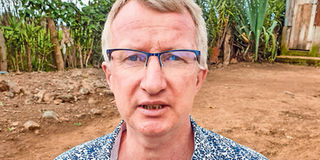To achieve food security, we must be seed secure

Ronnie Vernooy, a genetic resource policy specialist at Bioversity International, Holland. He indicates that for a society to be food secure, there must be seed security. PHOTO | RACHEL KIBUI | NATION MEDIA GROUP
What you need to know:
- Seed selection normally begins on the farm.
- Therefore, a farmer should spot and mark plants that germinate and flower fast and yield big.
- For best results, fill the containers to the brim to ensure they are airtight as air carries humidity.
- Some of the seed varieties that farmers have saved for long are no longer performing well under the same climatic conditions.
As farmers get ready for the first planting season, one of the things many are grappling with is the high cost of seeds. Thus, a good number will use farm-saved seeds. Rachel Kibui spoke to Ronnie Vernooy, a genetic resource policy specialist at Bioversity International, Holland, who shares tips on how one can conserve seeds to maximise yields
The quality of farm-saved seeds depends on the selection process. What should farmers observe at this point?
Seed selection normally begins on the farm. Therefore, a farmer should spot and mark plants that germinate and flower fast and yield big.
Among these, select the most healthy-looking seeds. They should be free from injuries or effects of diseases or destruction from moisture. These seeds should then be well-dried before storage.
How does one store seeds?
Set aside a space on the farm store or at your home dedicated exclusively for storing seeds. This space should be dry since moisture is destructive to seeds.
Besides, the place should be cool as high temperatures cause an increase in humidity, which compromises the seeds’ quality. Seeds should also be exposed to minimal light.
Some farmers may find it harder to achieve the moisture-free conditions …
That should not be expensive. All one needs are airtight containers. These can be the locally moulded clay pots or even recycled plastic containers, including beverage and water bottles. For best results, fill the containers to the brim to ensure they are airtight as air carries humidity.
Can farmers work with the National Gene Bank to save seeds and boost crop yields?
Certainly yes, this can be achieved by farmers coming together and collecting seeds then expressing their intention to store seeds in the gene bank.
However, these seeds should be well-selected and dried. While farmers can only store seeds for a short time, say, a maximum of two years at home, the same can last for decades at the National Gene Bank.
Then the seeds can be withdrawn from the bank for multiplication.
The effects of climate change are now apparent and the small farmer is feeling the pinch. Can seed-saving come to the rescue of farmers?
Some of the seed varieties that farmers have saved for long are no longer performing well under the same climatic conditions.
Farmers can boost their production by exchanging seeds with their colleagues from other regions and check which ones are more adaptive to the current climate conditions.
This can be done through seed fairs organised by farmer groups or relevant government authorities. This way, people can get seeds that are adaptive to current climate conditions.
The seed fairs should be combined with food fairs so that different cultural groups can borrow recipes from other participants.
Seed security or food security, which should come first?
For a society to be food secure, there must be seed security. While agri-innovators are burning midnight oil trying to ensure new, productive and adoptive seed varieties are available, many smallholder farmers still depend on farm-saved seeds.
The government should therefore pay attention to the ‘informal’ seeds sector.





